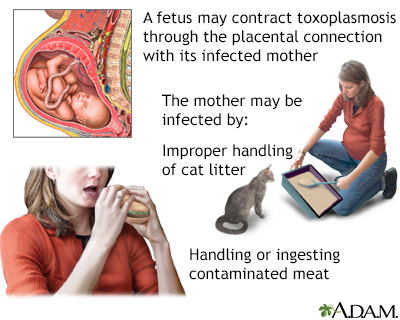Pregnancy SmartSiteTM
DefinitionToxoplasmosis is an infection due to the parasite Toxoplasma gondii. CausesToxoplasmosis is found in humans worldwide and in many kinds of animals and birds. The parasite also lives in cats. Human infection may result from:
Toxoplasmosis also affects people who have weakened immune systems. These people are more likely to have symptoms. The infection may also be passed from an infected mother to her baby through the placenta. This results in congenital toxoplasmosis. SymptomsThere may be no symptoms. If there are symptoms, they usually occur about 1 to 2 weeks after contact with the parasite. The disease can affect the brain, lung, heart, eyes, or liver. Symptoms in people with otherwise healthy immune systems can include:
Symptoms in people with a weakened immune system can include: Exams and TestsYour health care provider will perform a physical exam. Tests that may be done include:
TreatmentPeople without symptoms usually do not need treatment. Medicines to treat the infection include a specific antimalarial medicine and antibiotics. People with AIDS should continue treatment for as long as their immune system is weak, to prevent the disease from reactivating. Outlook (Prognosis)With treatment, people with a healthy immune system usually recover well. Possible ComplicationsThe disease may return. In people with a weakened immune system, the infection may spread throughout the body, leading to death. When to Contact a Medical ProfessionalContact your provider for an appointment if you develop symptoms of toxoplasmosis. Medical care is needed right away if symptoms occur in:
Also seek medical treatment right away if the following symptoms occur:
PreventionTips for preventing this condition:
Pregnant women and those with weakened immune systems should take the following precautions:
Pregnant women and those with HIV/AIDS should be screened for toxoplasmosis. A blood test can be done. In some cases, medicine to prevent toxoplasmosis may be given. ReferencesMcleod R, Boyer KM. Toxoplasmosis (Toxoplasma gondii). In: Kliegman RM, St. Geme JW, Blum NJ, et al, eds. Nelson Textbook of Pediatrics. 22nd ed. Philadelphia, PA: Elsevier; 2025:chap 336. Montoya JG, Boothroyd JC, Kovacs JA. Toxoplasma gondii. In: Bennett JE, Dolin R, Blaser MJ, eds. Mandell, Douglas, and Bennett's Principles and Practice of Infectious Diseases. 9th ed. Philadelphia, PA: Elsevier; 2020:chap 278. | |
| |
Review Date: 12/31/2023 Reviewed By: Jatin M. Vyas, MD, PhD, Associate Professor in Medicine, Harvard Medical School; Associate in Medicine, Division of Infectious Disease, Department of Medicine, Massachusetts General Hospital, Boston, MA. Also reviewed by David C. Dugdale, MD, Medical Director, Brenda Conaway, Editorial Director, and the A.D.A.M. Editorial team. The information provided herein should not be used during any medical emergency or for the diagnosis or treatment of any medical condition. A licensed medical professional should be consulted for diagnosis and treatment of any and all medical conditions. Links to other sites are provided for information only -- they do not constitute endorsements of those other sites. No warranty of any kind, either expressed or implied, is made as to the accuracy, reliability, timeliness, or correctness of any translations made by a third-party service of the information provided herein into any other language. © 1997- A.D.A.M., a business unit of Ebix, Inc. Any duplication or distribution of the information contained herein is strictly prohibited. | |

 Slit-lamp exam
Slit-lamp exam Congenital toxopla...
Congenital toxopla...
